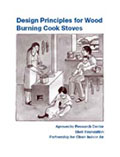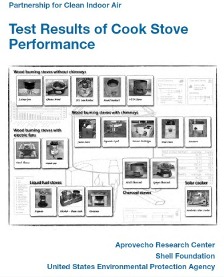Resources
Design Principles for Wood Burning Cookstoves (revised June 2006)
The Partnership for Clean Indoor Air has published the Design Principles for Wood Burning Cookstoves. You can download an electronic copy in PDF format below. If needed, you can download the current version of Adobe Acrobat reader free from Adobe's website.
You may order a free copy of Design Principles for Wood Burning Stoves, EPA-402-K-05-004, on-line at www.epa.gov/epahome/publications.htm. You may also order by fax at 513-489-8695. You will need to provide the publication name and number, your complete mailing address (i.e., name, organization, street address, city, state, zip code, country) and phone number.
Retained Heat Cooker Guide
The Guide to Designing Retained Heat Cookers was written by Don O'Neal, Vice President of HELPS International and Special Projects Director. The development of the HELPS International Retained Heat Cooker was funded by a grant from the United States Environmental Protection Agency to further the mission of the Partnership for Clean Indoor Air, to improve health, livelihood, and quality of life by reducing exposure to air pollution, primarily among women and children, from household energy use. You can download an electronic copy in PDF format by clicking on the link below. If needed, you can download the current version of Adobe Acrobat reader free from Adobe's website.
You may order a free copy of the Guide to Designing Retained Heat Cookers, EPA-402-K-06-004, on-line at www.epa.gov/epahome/publications.htm. You may also order by fax at 513-489-8695. You will need to provide the publication name and number, your complete mailing address (i.e., name, organization, street address, city, state, zip code, country) and phone number.
PCIA Fact Sheet
The PCIA factsheet provides information on the activities of the Partnership for Clean Indoor Air. These documents are in PDF format. You can download the current version of Adobe Reader from Adobe's website.
PCIA Design and Performance Guidance
The Partnership for Clean Indoor Air has made available draft design and performance guidance for public comment. These guidelines are the product of the PCIA workshop held in early 2004 in Seattle, Washington, to establish broad design and performance principles for home cooking and heating practices that can be used by a wide range of organizations worldwide. The workshop was held in conjunction with the annual conference of Engineers in Technical and Humanitarian Opportunities of Service-learning (ETHOS). Household energy and indoor air pollution experts gathered to: define the terms "clean," "efficient," "affordable," "reliable," and "safe" as they relate to home cooking and heating practices; identify best practices; and establish design and performance guidelines.
In order for these guidelines to take into account the vast experience of household energy implementers around the world, USEPA is soliciting comments. You can download an electronic copy in PDF format by clicking on the link below. If needed, you can download the current version of Adobe Acrobat reader free from Adobe's website.
Household Energy, Indoor Air Pollution and Health Country Overviews
Winrock International has compiled household energy, indoor air pollution and health overviews of China, India, South Africa and Guatemala, under a cooperative agreement with USEPA. The Nepal and Philippines overviews were funded by the USAID. These overviews are intended to be a resource for donors and implementers working on household energy and health programs in these countries. The reports present information on significant household energy programs, health sector priorities and programs, key actors in energy and health, and experiences and lessons learned relevant to moving toward more integrated approaches to reducing indoor air pollution and associated health impacts of unhealthy cooking and heating practices.
Drawing largely on existing literature and insights from in-country partners, the reports have been co-authored by household energy and health specialists experienced with each country. The authors aimed to compile the most salient information available to help frame the context for possible synergies between the energy and health sectors; at the same time, the authors recognize the greater complexity of the household energy and health arena, including the importance of programs and actors from other sectors (environment, education and rural development, among others). Although the reports are not comprehensive in this sense, it is hoped that as partners of PCIA, you will find the compiled information useful for your own work.
The reports are available in PDF format. You can download the current version of Adobe Acrobat reader from Adobe's website. We welcome feedback and in particular will appreciate knowing what aspects of these reports you find most useful and why. Please send us your comments! PCIAonline@yahoo.com.
Catalog of Methods for Evaluating Impacts of Interventions
In 2005, PCIA and the World Health Organization (WHO) organized a series of five regional workshops to build regional capacity in the area of household energy and indoor air pollution monitoring. These training workshops were designed to empower governmental and non-governmental organizations as well as research institutions to evaluate the impact of intervention projects or programmes. This catalog of methods provides a brief summary of the content of the five main modules of the workshop:
* Evaluation basics;
* Indoor air pollution monitoring;
* Monitoring impacts on health and well-being;
* Monitoring stove performance; and
* Monitoring socioeconomic impacts
The related proceedings of these workshops "Measuring Change: Indoor Air Pollution and Household Energy Monitoring" can be found on the PCIA Proceedings page.
Test Results of Cook Stove Performance
The Partnership for Clean Indoor Air is pleased to make available a new publication entitled "Test Results of Cook Stove Performance." This document was developed by Aprovecho Research Center under a grant from the Shell Foundation to provide technical support to household energy and health projects and to ensure that the projects’ designs represent the best available technical practices. Test Results of Cook Stove Performance represents a major step forward in developing an integrated approach to cook stove design. For the first time, a variety of stoves from across the world have been tested in a variety of ways and the results presented here for all to review.
Click HERE to view the Test Results of Cook Stove Performance document. This information was also presented in a webinar on January 12. For a recording of the webinar, please see the webinar proceedings.
Please note -- due to file size the document may take a few moments to load on your computer.
To hear Dean Still and Nordica MacCarty from Aprovecho Research Center discuss the newly released guide, listen to the podcast on the PCIA's media page.
Solid Fuel Household Cook Stoves: Characterization of Performance and Emissions
This report details the results of performance and pollutant emissions testing performed by the U.S. Environmental Protection Agency for 10 solid fuel household cookstoves, and 4 fuels. The report includes recommendations to improve the ability to replicate results between testing laboratories.
|


